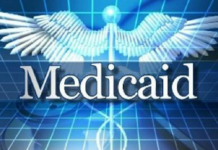The stimulus money looks tantalizing.
An estimated $1.25 billion.
It would be almost enough to cover the state’s decline in revenues for this year and next.
But the state doesn’t think it can touch it — at least for filling holes in the budget.
Kansas state government is expected to get at least $1.25 billion — maybe more — out of the $2.2 trillion coronavirus stimulus package signed into law last month.
It’s a big chunk of change but for one small problem.

State officials don’t believe the money can be used to offset any declines in revenue that have accompanied the pandemic sweeping the country as the economy slows down.
“As of today, I would tell you that it was clear that we couldn’t use it to backfill or supplant revenue,” Budget Director Larry Campbell said Monday when the state’s new revenue estimates were announced.
Campbell said the stimulus money — as it’s understood now — needs to go to direct costs for fighting COVID-19.
He said there’s a lot of latitude for spending the money, but it “can’t, as far as we know, just supplant revenue declines.”
Campbell said the state has been waiting on guidance for several weeks from the Treasury Department about how that money can be used.
He said the agency has indicated it wants to be flexible on how the money is used but has yet to provide any more instructions for how the funds can be spent.
“Everyone wants to know and there are a ton of questions, and they’re all recycling the same questions for the last three or four weeks,” he said.
The language in the stimulus bill, however, explicity says the states shall only use the money for “necessary” expenditures related to the health emergency related to the COVID-19 virus.
The emerging fiscal crisis is expected to blow holes in state budgets as governments impose social-distancing restrictions intended to control the spread of the virus.
Kansas cut revenue projections by $1.27 billion for this fiscal year and next. It would be facing a $650 million deficit in the fiscal year starting July 1.
It’s a problem that’s expected to confront every state, potentially damaging the country’s economy further.
Colorado is now projecting an $800 million decline next year. Hawaii is estimating a $225 million decline, while New York is expected to see revenues plummet $15 billion.
Moody’s projects that the combined repercussions of lower revenues and higher spending demands for services such as Medicaid will cost states between $158 billion and $203 billion through the end of fiscal year 2021.
Moody’s estimated the amount of lost state revenues could grow to $300 billion by fiscal year 2022.
“The economic fallout from the COVID-19 pandemic is set to impose incredible stress on state government budgets,” Moody’s says in its analysis.
“This stress will be enough to outmatch even some of the most well-prepared states, and the potential fiscal actions that policymakers may be forced to take in response will have significant consequences for the U.S. economy,” the Moody’s report says.
Without additional federal aide, Moody’s said several states are projected to see potential general fund budget shortfalls of 30% to 40%, leading to cuts in basic services.
Moody’s notes that this fiscal crisis is very different from anything in the past because state governments not only must deal with revenue shortfalls but spend the money needed to control the virus.
“In the age of COVID-19, matters are a bit more complicated,” the Moody’s report says.
“In addition to the indirect economic implications for state budgets, policymakers must also contend with the direct costs associated with fighting the virus itself,” Moody’s explains.
“Given the unprecedented nature of the crisis, coming up with exact estimates of what will need to be spent on everything from masks to ventilators to emergency personnel is virtually impossible at this stage of the game.”
Moody’s isn’t the only one painting a grim picture for the states.
The left-leaning Center on Budget and Policy Priorities estimates that states are on the cusp of facing shortfalls totaling more than $500 billion in just one fiscal year.
The shortfalls nationally could come in closer to $360 billion after including federal aid provided so far and money the states will use in their reserve funds to offset the deficits.
The nation’s governors recognize the financial issues they’re facing, which is why they are asking for another round of stimulus dollars that could be directed to covering declines in revenues. They want $500 billion more for revenue losses.
“Without this relief, states will be confronted with the prospect of cuts to essential services,” Maryland Gov. Larry Hogan and New York Gov. Andrew Cuomo said in a joint statement last week.
“This will make it that much harder to have a strong economic recovery, which is a top priority for the president and for all of the governors,” they said.
Meanwhile last week, the executive director of the National Conference of State Legislatures sent a letter to congressional leadership asking for $300 billion that could be used for revenue declines.
The NCSL projects revenue losses of between 15% and 20% in nearly every state, meaning a total loss nationally of between $300 billion and $400 billion.
“It is now painfully evident that the pandemic will have devastating effects on state budgets and our economy; therefore, additional stimulus funding is critical,” NCSL executive director Tim Storey wrote to Congress.
On Sunday, U.S. Sens. Bill Cassidy of Louisiana and Bob Menendez of New Jersey announced legislation that would create a $500 billion fund for state and local governments.
About a third of the money would go to “eligible entities” based on revenue losses relative to pre-COVID-19 projections.
Kansas Gov. Laura Kelly alluded to the necessity of federal stimulus money as a way to help salve the state’s budget wound.
“If the feds respond to the cries for help on backfilling revenue holes, then we would use that funding and, hopefully, be able to avoid a lot of cuts to essential services,” she said.
The governor said Tuesday she is working with her budget staff to come up with short-term plans to deal with the shortfall, which she characterized as “jaw dropping.”
“We are cautiously optimistic that we may be able to make some strategic decisions that help offset painful cuts to critical services in the current fiscal year,” she said.
The governor wasn’t prepared to be specific about her plans but said it would likely involve shifting money within the budget to cover areas of need.
“There are ways that money can be moved around within the state system, and that’s the kind of thing we’ll look at,” Kelly said.
“Do we have money in one area that might be able to be shifted over here to fill a potential hole in another?”
Kelly noted the talks in Washington about a new stimulus bill.
“In Washington right now, they are talking about stimulus 3.5 and stimulus 4 and, hopefully, one of those packages will include some additional revenues for states to use to offset the budget shortfalls.”
















